The Fractal Design Ion+ 760P 80Plus Platinum PSU Review: A High-End PSU For the Mainstream Builder
by E. Fylladitakis on August 6, 2019 9:00 AM ESTExternal Appearance
A quick look at the Fractal Design Ion+ 760P PSU reveals a sleek design and a unique chassis that is not quite like most other ATX PSUs. Officially, the PSU isn't quite ATX compliant either; it adheres to everything except the ATX size specification, where the chassis is a longer 150 mm deep, a necessary adjustment in order to fit a 140 mm cooling fan. The chassis of the PSU is coated with a satin black paint, which is excellently applied and highly resistant to smears and fingerprint marks.
Fractal Design split the standard sticker with the electrical specifications and certifications of the PSU into two parts, placing the sticker with the basic electrical specifications on the rear side of the PSU and making it visible from the rear of the PC case. The rear side is, in terms of aesthetics, interesting, as the designer ditched the standard honeycomb or circular vents and implemented a Morse code dot-like pattern design. Other than that, we can also spot a regular on/off switch and the AC cable receptacle.
The bottom and top sides of the PSU are entirely clean and smooth. Fractal Design went with a parallel wire fan finger guard, as it is supposed to reduce aerodynamic noise a little bit in comparison to standard circular guards. The sides of the PSU are almost entirely clean as well, with only a small version of the company’s logo printed on each side.
The front side is perhaps the most interesting part of the PSU. It houses the eleven connectors for the modular cables, with a very subtle legend painted in between the two series of connectors. All of the connectors are black but are keyed, meaning that no cable can be inserted into the wrong connector. There is also a “Zero RPM” switch that turns the unit’s hybrid cooling mode on or off. By default, the Ion+ PSU will not start the fan at all until temperatures require it to do so, but users can opt to force the fan to stay on at all times should they wish to do so. Note that this will not affect the thermal circuitry of the PSU, which will still adjust the fan’s speed according to the operating conditions.
Internal Design
Fractal Design rebranded the cooling fan of the PSU, and we could not identify the original manufacturer. Regardless, we can tell that it is a 140 mm fan with a fluid dynamic bearing (FDB) engine. It has a maximum rotational speed of about 1800 RPM. Fractal Design also claims that they greatly optimized the fan’s design by adding a counter-balance magnet to reduce axial tension on the bearing and tweaked the design of the blades to reduce the fan’s noise.
The OEM behind the creation of the Fractal Design Ion+ 760P PSU is Sirfa (also known as High Power), a manufacturer known for their mid-range designs. This, however, is not a platform that we have seen before. Fractal Design’s involvement on the design of the PSU is very apparent, as Sirfa rarely uses good heatsinks, especially on their higher efficiency products. The heatsinks of the Ion+ 760P are strikingly advanced, especially considering the lower-than-average amount of heat generated by the PSU thanks to its high efficiency and overall lower power output.
The input filtering stage is textbook in design and consists of four Y capacitors, two X capacitors, two filtering inductors, and one surge-suppressing MOV. The unit has two input conversion bridges that can be found on their own small heatsink. The enclosed APFC coil and two Rubycon 400V/470μF capacitors stand right between the heatsinks that hold the APFC and primary inversion circuit parts.
The primary inversion circuit is relatively simple, with two MOSFETs forming a standard LLC resonant half-bridge topology. The unit then generates a single 12V line via the MOSFETs that are attached to the bottom side of the PCB. The slim silver heatsinks on top of the PCB assist on the cooling of the secondary side MOSFETs, which are also dissipating part of their losses via the chassis of the PSU. A secondary vertical PCB holds the DC to DC conversion circuits that generate the 3.3V and 5V lines. Finally, the generated power is transferred to the PCB that holds the cable connectors via a soldered bar, minimizing losses.


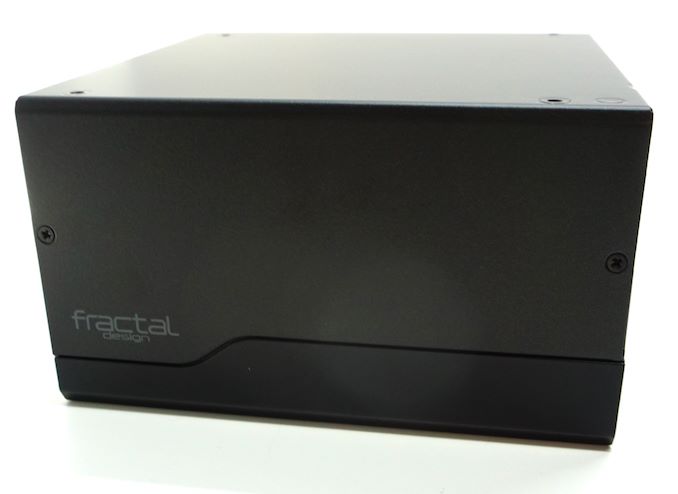
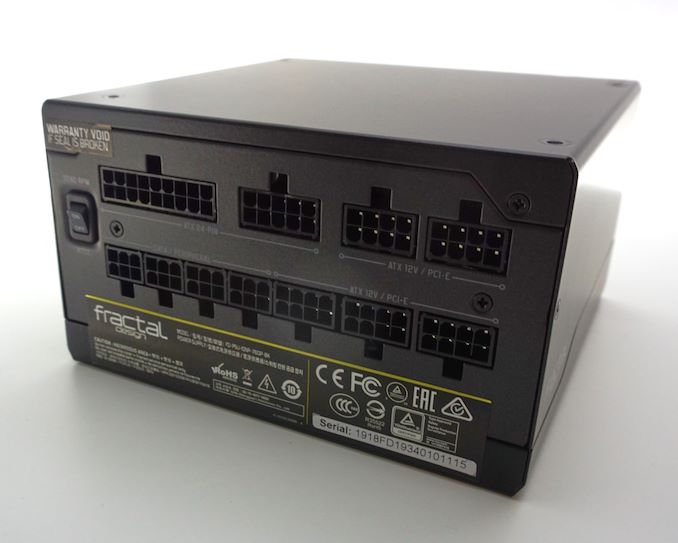

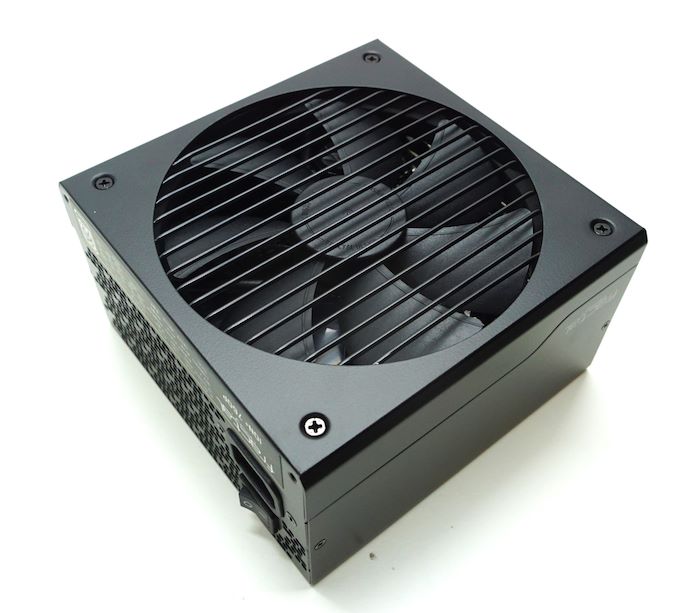
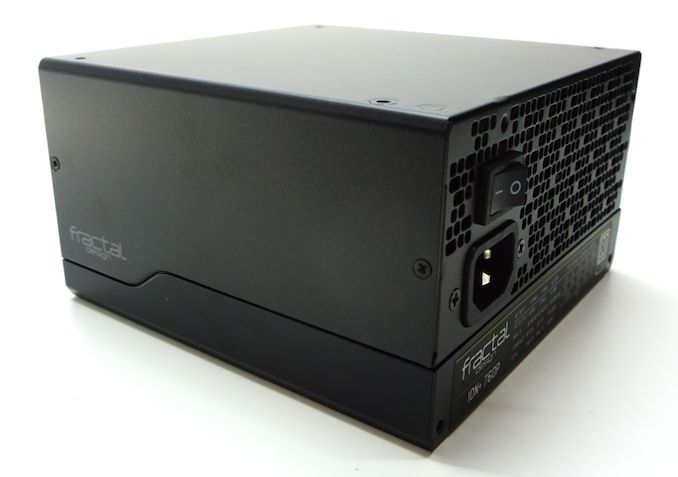

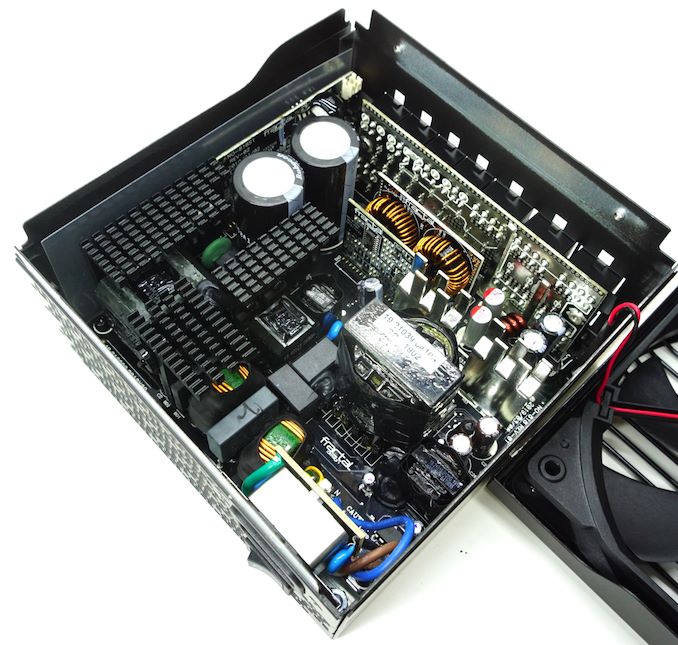

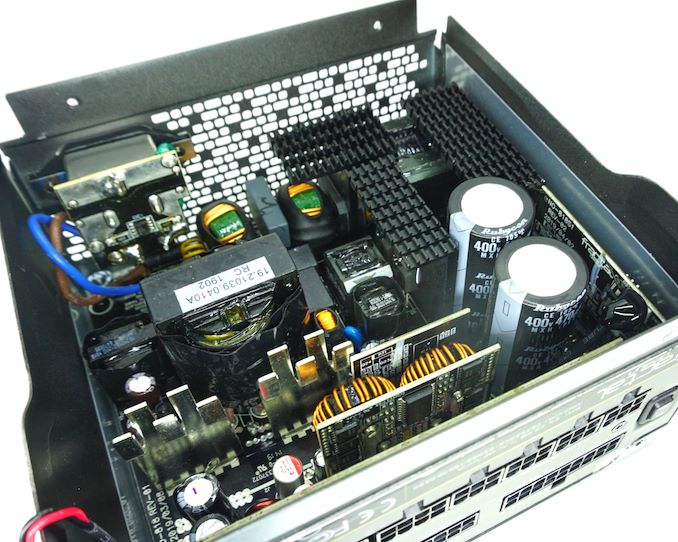








27 Comments
View All Comments
mat9v - Tuesday, August 6, 2019 - link
I wonder, did they not get the memo, that "Warranty void if seal is broken" stickers are illegal now?PeachNCream - Tuesday, August 6, 2019 - link
They're not illegal. It's just that voiding a warranty based solely on breaking a factory seal (unless that seal is critical to the operation of the item in question like say opening a helium filled HDD casing) is no longer legally enforceable in the United States when it is reasonably possible for the owner to perform self-service or upgrades. In something like a desktop PC case filled with components that can be swapped or can accept new hardware it's an obvious thing that you can't void something out by adding RAM. A PSU that lacks user serviceable parts is an arguably different critter though so that sticker might actually pass muster in court.notashill - Tuesday, August 6, 2019 - link
Those stickers have been unenforceable since before PCs even existed, the Magnuson–Moss Warranty Act was passed in 1975.PeachNCream - Tuesday, August 6, 2019 - link
Courts had to later decide whether or not the law applied to PC hardware and there was subsequent litigation regarding the matter that verified the voiding a warranty was not something that could be enforced for computing equipment. I'd be reluctant to say the decision was broad enough to encompass component-level items like power supplies though as there are no parts inside that are designed with end user modular upgrade capabilities in mind which circles back to my prior post. Where the is obvious user upgrade and replacement capabilities inside a PC, the lack inside a power supply gives the PSU manufacturer a lot more leverage to legitimately void a warranty if tampering is evident.mickulty - Tuesday, August 6, 2019 - link
It's a PSU, not a laptop - you're not going to upgrade it with third-party components.The provision that made the stickers a problem on *laptops and games consoles* is that "No warrantor of a consumer product may condition his written or implied warranty of such product on the consumer’s using, in connection with such product, any article or service (other than article or service provided without charge under the terms of the warranty) which is identified by brand, trade, or corporate name".
In the context of games consoles this was decided to be relevant as people should be able to have a third-party technician upgrade their hard drive, or do it themselves - rather than being restricted to "PlayBox authorised technicians". However it is not relevant to a power supply.
It should also be noted that this law does not prevent the use of tamper seals, even in laptops and games consoles - it just requires that they not mislead consumers about their rights.
It's also worth mentioning that some GPU manufacturers who have been criticised for the stickers, such as XFX, will install a third-party cooler for *free* and so are completely entitled to condition the warranty on you not installing the cooler yourself (even though they'll usually be happy to authorise you to do so and make a note that your warranty remians intact if you make contact).
Ultimately it's complicated and '"Warranty void if seal is broken" stickers are illegal now' is at best a serious oversimplification.
kyuu - Tuesday, August 6, 2019 - link
While the stickers aren't "illegal", they aren't enforceable. There's nothing complicated about it. The law is that a company cannot void a warranty simply because a user breaks a seal. A warranty can only be legally voided if the company can prove that the user's actions actually resulted in the damage the user is attempting to make a warranty claim for. Otherwise, the company must honor their warranty. An arbitrary determination of what is "user-serviceable" or not by a company does not matter.TheUnhandledException - Wednesday, August 7, 2019 - link
Those stickers are unenforceable period. Unlike the prior posters claim they aren't "illegal" they are just a lie and totally unenforceable. To void a warranty requires that the manufacturer prove the user damaged the device. PERIOD. That is true for consoles, that is true for power supplies, hell that is true for lightbulbs.zepi - Wednesday, August 7, 2019 - link
Over 95% of world population doesn't live in US and therefore US legislation is mostly irrelevant for them.MobiusPizza - Thursday, August 8, 2019 - link
Exactly, I know Anandtech is a US site, but a lot of readers are international.I am surprised how narrow minded most Americans are about globalization, it's like they live in a bubble, no offense, just find it funny that's all. Surely that sticker is there not because they are targeting US customers and it may well be unenforceable in the US, but for majority of the population in the world the legislation is different. This should be the first thing that spring into the mind for those commenting.
Skeptical123 - Wednesday, August 14, 2019 - link
MobiusPizza come on man, I thought people on this site were better than that -"I am surprised how narrow minded most Americans are about globalization," that could be said about almost any other country on the planet. Brexit being the comically obvious example. We just have the largest English speaking population and trashing on "americas" is like trashing on one age demographic for the media. While not necessarily wrong there just doing it for the clicks/views. Also while globalization is very much increasing make no mistake we are still about a quarter of the GLOBAL GDP. Almost any product on the market at any reasonable scale is made for the US market and adapted for other countries. (I’m not saying this is a or bad thing) Do some research into standards body and that will become apparent. Phones, planes etc. Those warranty stickers are very much to deter US customers from opening up devices.